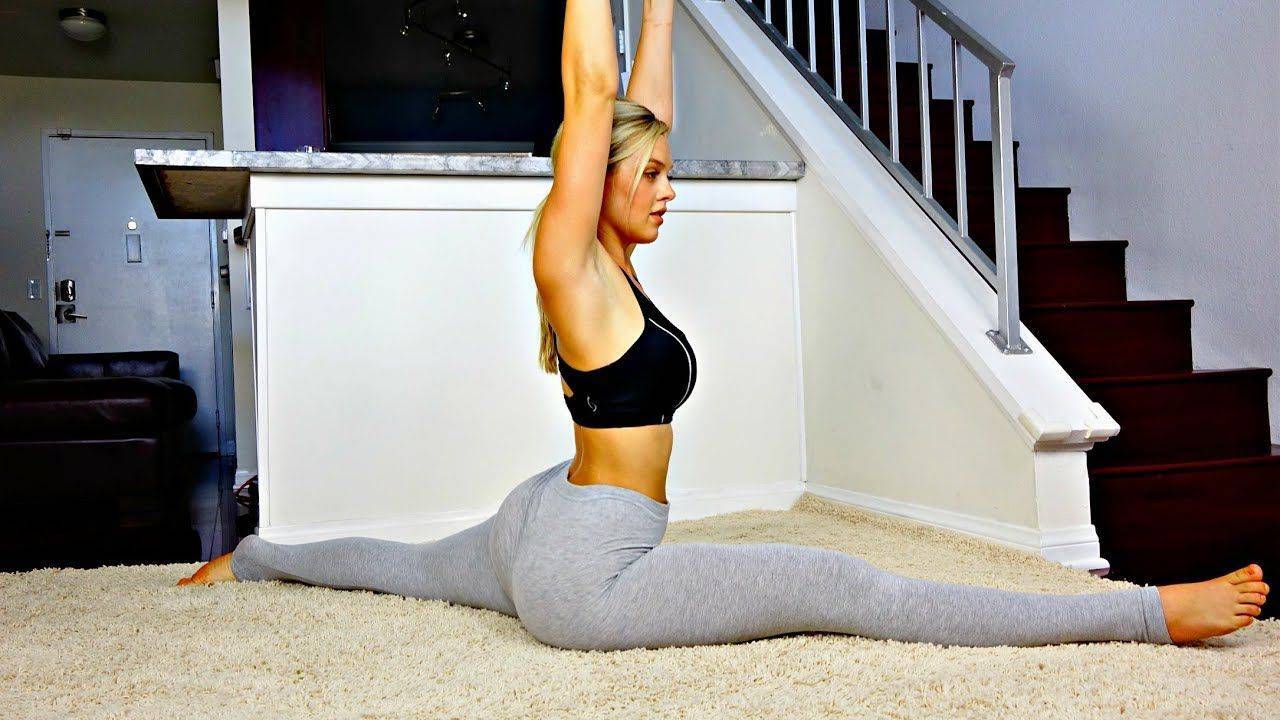The key to enhanced flexibility with exercises tailored for optimal results. Exercise is best for flexibility, often overlooked in fitness pursuits.
In this article, we will delve into the world of Flexibility, exploring various exercises that can enhance your range of motion and contribute to a more well-rounded fitness routine.
Definition of Flexibility

In physical fitness, Flexibility refers to the body’s ability to efficiently move joints and muscles through a full range of motion. It is essential to general health and well-being, contributing to improved mobility and functionality.
The definition of Flexibility encompasses both static and dynamic aspects. Static Flexibility involves holding a stretch to elongate muscles, while dynamic Flexibility incorporates movement into stretches, promoting increased blood flow and adaptability.
This attribute is crucial for athletes seeking enhanced performance and individuals of all ages and fitness levels. Achieving and maintaining Flexibility through regular exercise can prevent injuries, enhance posture, and support a more active and agile lifestyle.
Factors Affecting Flexibility
Flexibility, a key component of physical fitness, is influenced by various factors that play pivotal roles in an individual’s ability to move joints and muscles through their full range of motion. One significant factor is age, as Flexibility tends to decrease with aging due to changes in muscle elasticity and joint mobility.
Genetics also contribute, as some individuals may inherently possess greater natural Flexibility based on their genetic makeup. Additionally, physical activity is crucial; regular stretching and flexibility exercises promote suppleness.
These factors are essential for tailoring flexibility training programs to address individual needs and optimize overall Flexibility, fostering improved mobility and reduced risk of injuries.
Benefits of Flexibility Exercises
Flexibility exercises offer many benefits that extend beyond the physical realm, influencing overall well-being. One key advantage is the significant improvement in range of motion, allowing joints and muscles to move freely.
Enhanced Flexibility improves posture, reducing the risk of musculoskeletal issues and injuries. Moreover, incorporating flexibility exercises into a routine promotes increased blood flow to muscles, fostering improved circulation and nutrient delivery.
These exercises prevent injuries and condition muscles and joints to adapt to various movements and stresses. Athletes, in particular, experience heightened athletic performance, benefiting from increased agility, coordination, and balance.
Flexibility exercises also play a pivotal role in stress relief, promoting relaxation and positively impacting mental health. The holistic advantages of flexibility exercises underscore their importance in fostering a balanced, healthy lifestyle.
Different Types of Exercises for Flexibility
Regarding enhancing Flexibility, a diverse range of exercises caters to individuals with varying preferences and fitness goals. The “Different Types of Exercises for Flexibility” category encompasses a spectrum of techniques, each offering unique benefits.
Static stretching involves holding positions to elongate muscles, while dynamic stretching incorporates movement into stretches, promoting increased blood flow. Proprioceptive Neuromuscular Facilitation (PNF) takes Flexibility to an advanced level by integrating muscle contraction and relaxation. Yoga, an ancient practice, improves Flexibility through poses like Downward Dog and Cobra and nurtures a holistic mind-body connection.
Pilates, with its core-focused exercises, seamlessly integrates Flexibility into routines. Tai Chi, a martial art, emphasizes slow, deliberate movements, enhancing Flexibility, balance, and mental focus. This broad array of exercises ensures that people are free to select the strategy that most closely aligns with their preferences and fitness objectives.
Stretching Exercises for Flexibility
Stretching exercises for Flexibility are pivotal in enhancing the range of motion and promoting overall physical well-being. These exercises involve deliberate elongation of muscles, helping to improve Flexibility by allowing joints to move through their full capacity.
Static stretching, a common form, requires holding a position that targets specific muscle groups, promoting relaxation and elongation. On the other hand, dynamic stretching incorporates movement into stretches, enhancing blood flow and warming up muscles before more strenuous activities.
Proprioceptive Neuromuscular Facilitation (PNF) is an advanced technique involving alternating contraction and relaxation, effectively improving Flexibility. Incorporating these stretching exercises into a regular fitness routine contributes to increased mobility, reduced muscle tension, and a decreased risk of injuries, making them a valuable component of any well-rounded exercise program.
Yoga for Flexibility

Yoga for Flexibility is a holistic and time-tested approach to enhance the body’s range of motion and promote overall suppleness. Rooted in ancient traditions, yoga incorporates a series of poses and stretches designed to elongate muscles, improve joint mobility, and increase Flexibility.
The practice involves controlled movements synchronized with deep, mindful breathing, fostering a profound mind-body connection. Yoga’s versatility makes it accessible for individuals of all fitness levels, offering modified poses for beginners and advanced variations for seasoned practitioners.
The gentle yet powerful nature of yoga allows for gradual progress in Flexibility, promoting physical agility and mental relaxation. Including yoga in your practice can result ina balanced, flexible body, providing many benefits for physical and mental well-being.
Pilates for Flexibility
Pilates for Flexibility is a transformative exercise approach designed to enhance core strength and Flexibility. Originating from the mind of Joseph Pilates, this fitness method emphasizes controlled movements and precise breathing to engage muscles and improve Flexibility.
Pilates incorporates a variety of exercises that focus on elongating muscles and promoting a full range of motion, making it an ideal practice for individuals seeking to increase Flexibility in a low-impact manner.
Combining stretching and strengthening exercises in Pilates improves muscle flexibility, joint mobility, and posture. Whether you’re a fitness enthusiast or a beginner, Pilates for Flexibility offers a holistic approach that enhances your body’s Flexibility and promotes overall well-being.
Tai Chi for Flexibility
Tai Chi, an ancient Chinese martial art, is renowned for its meditative and stress-relieving benefits and significant impact on Flexibility. Incorporating slow, deliberate movements, Tai Chi engages the entire body, promoting a wide range of motion in joints and muscles.
The fluid, dance-like sequences in Tai Chi encourage gentle stretching and lengthening of muscles, improving flexibility over time. This low-impact exercise is particularly suitable for individuals of all ages, including those with joint concerns.
Tai Chi’s emphasis on balance and posture further enhances Flexibility, making it an excellent choice for those seeking a holistic approach to physical well-being. The contemplative and attentive elements of Tai Chi also add a unique dimension to flexibility training, fostering a harmonious connection between the body and mind.
Choosing the Right Exercise for Your Body
“Choosing the Right Exercise for Your Body” is a crucial choice that could have a big effect on your fitness journey. This keyword emphasizes the importance of selecting exercises that align with your unique physique, preferences, and fitness goals.
It involves a thoughtful process of self-assessment, considering factors such as current fitness levels, existing health conditions, and personal interests. Tailoring your workout routine to suit your body enhances the exercises’ effectiveness and reduces the risk of injury.
Whether you opt for strength training, cardiovascular exercises, or flexibility-focused activities, the key is to strike a balance that promotes overall well-being. This keyword underscores the notion that a personalized approach to fitness contributes to a sustainable and enjoyable exercise routine, ensuring that you stay motivated on your path to a healthier lifestyle.
Incorporating Flexibility into Your Fitness Routine
Incorporating Flexibility into your fitness routine is a pivotal step toward achieving a well-rounded and holistic approach to physical well-being. This process involves integrating exercises and activities that focus on enhancing the range of motion of your joints and muscles.
By doing so, you improve your overall flexibility and contribute to injury prevention, better posture, and increased athletic performance. Whether through dedicated stretching sessions, participation in yoga classes, or the inclusion of dynamic warm-up routines, the goal is to strike a balance that complements your existing strength and cardiovascular training.
Flexibility training benefits your body physically and promotes mental well-being by fostering mindfulness and a deeper connection between your body and mind. Embrace the journey of incorporating Flexibility into your fitness routine for a more agile, resilient, and balanced lifestyle.
Common Myths about Flexibility
Common myths about Flexibility often hinder individuals from unlocking the full potential of their bodies. One prevalent misconception is that Flexibility is reserved for the young or naturally bendy, excluding others.
Contrary to this belief, Flexibility is attainable for everyone, regardless of age or initial flexibility level. Another myth suggests that daily stretching is essential, yet overstretching can lead to injuries.
Dispelling these myths is crucial for fostering a realistic understanding of Flexibility and encouraging individuals to embrace tailored, consistent flexibility exercises that suit their unique bodies and fitness goals.
Real-Life Success Stories
“Real-life success Stories” encapsulate narratives of individuals who have triumphed over challenges, achieved significant milestones, or experienced personal growth.
These stories are powerful testimonials, inspiring and motivating others facing similar struggles. Whether in fitness, entrepreneurship, or personal development, real-life success stories provide tangible examples of perseverance and resilience.
They offer insights into overcoming obstacles, making them relatable and encouraging. These stories celebrate accomplishments and offer valuable lessons, making them a source of inspiration for those seeking motivation and a sense of possibility in their lives.
Tips for Safe and Effective Flexibility Training
When delving into flexibility training, understanding how to ensure safety and effectiveness is paramount. The keyword “Tips for Safe and Effective Flexibility Training” encompasses guidance crucial for individuals embarking on a journey to enhance their Flexibility.
These tips include emphasizing gradual progression to prevent overexertion, advocating for proper warm-up routines to prepare muscles and joints, and highlighting the importance of avoiding overstretching to prevent injuries.
This comprehensive approach fosters a safer training environment and maximizes the effectiveness of flexibility exercises, promoting a balanced and sustainable fitness routine.
FAQ
How often should I perform flexibility exercises?
The frequency depends on your fitness goals, but incorporating flexibility exercises 2-3 times per week is a good starting point.
Can anyone improve Flexibility, regardless of age?
Yes, individuals of all ages can improve Flexibility with consistent effort and appropriate exercises.
Is yoga suitable for beginners?
Absolutely! Many yoga poses have modified versions, making them accessible for beginners.
Can I do flexibility exercises every day?
While daily flexibility exercises are possible, listening to your body and allowing for rest when needed is essential.



